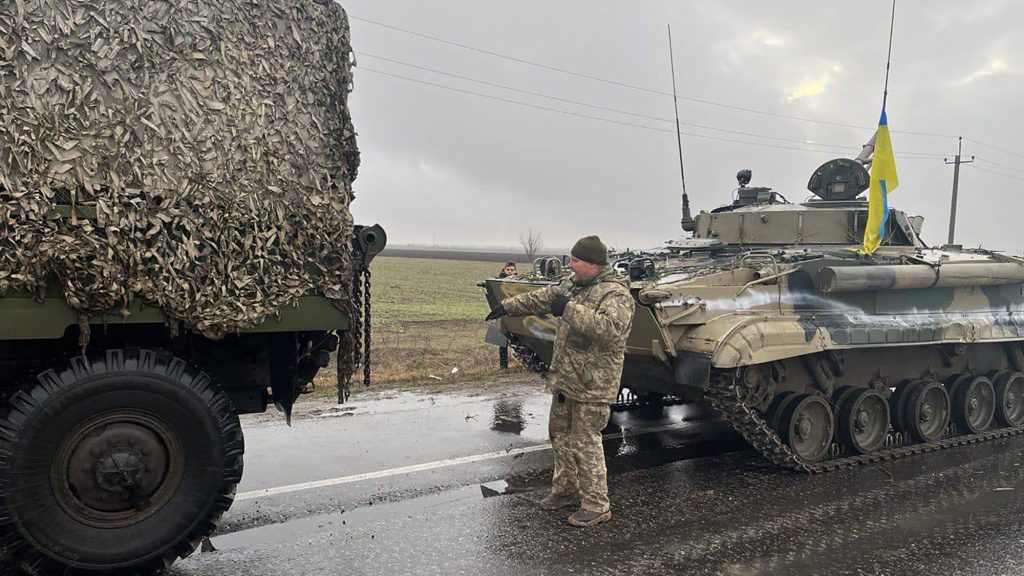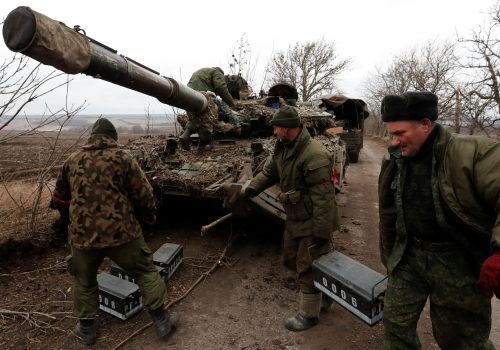In light of the ongoing Russia crisis, the Scowcroft Center’s Forward Defense (FD) practice will share weekly assessments of the latest force developments surrounding Ukraine, leveraging the expert perspectives of our senior military fellows. The opinions, conclusions, and recommendations expressed or implied here are solely those of the authors and do not represent the views of the Department of Defense or any other US government agency.
The bottom line
During the first week of the war, Russian ground forces have become bogged down outside of the northern Ukrainian cities of Kharkiv and Kyiv due to their failure to establish air superiority (which has resulted in significant aircraft and helicopter losses), too few troops to execute three simultaneous thrusts (toward Kyiv and Kharkiv, and north from Crimea), poor coordination of fires and maneuver, significant logistical issues, and stronger than expected Ukrainian resistance. Russia’s naval superiority in the Black Sea has contributed to success in its southern area of operations, with Russian forces breaking out from the Crimean Peninsula and taking territory in southern Ukraine. Although Ukraine has fought well and disrupted plans for a quick and decisive Russian victory, the situation is still perilous. Russia is moving to encircle Kyiv and Kharkiv and appears to have switched to indiscriminate long-range fires—resulting in significant collateral damage in residential areas—and is making significant progress in the south.
Russian military progress
Air and air defense: Russia has failed to establish air superiority and is unable to provide required air support to its ground forces.
- Battle for Hostomel (the Battle of Antonov Airport). On February 24 and 25, Russia and Ukraine fought a ferocious battle for Antonov Airport in Hostomel, just ten kilometers northwest of Kyiv. Russia conducted a large air assault to take control of the airfield, but Ukrainian forces held throughout February 24. According to Ukrainian sources, during the battle, eighteen IL-76 Candid cargo aircraft took off from Pskov Airport in Russia and were heading to Antonov Airport, likely loaded with either paratroopers or heavy equipment to support the paratroopers. We surmise the airlifted force was designed to help spearhead the Russian attack on Kyiv. The Ukrainian defense of the airfield on February 24 slowed the advance on Kyiv, possibly preventing a rapid capture of the capital. The Russians eventually took control of the airfield on February 25, but reporting indicated that the airfield was heavily damaged and nonoperational.
- Russia’s has failed to establish air superiority and is suffering long aircraft and helicopter losses. According to the Ukrainian Ministry of Defense, Russia lost thirty-one planes and thirty helicopters in the first week of the conflict. Though all the Ukrainian kill claims cannot be independently verified, it is clear to us that Russia is losing aircraft and helicopters at a damaging rate. We believe that a root cause of these Russian losses is the Kremlin’s failure to secure even localized air superiority over Kyiv. As a result, Russian aircraft and helicopter losses have been surprisingly high and unsustainable, Russian attack aircraft and helicopters do not have the freedom of movement to provide close air support to their columns of mechanized forces, and Ukraine’s Turkish-made TB2 unmanned aerial vehicles have been able to operate and destroy a shocking number of Russian vehicles. There are a multitude of reasons why the Russian air campaign has failed to develop air superiority:
- Limited effectiveness of the stand-off weapons (SOW) strike. According to the US Department of Defense, Russia launched approximately one hundred cruise and ballistic missiles and employed seventy-five bombers in attacks on the first night of the conflict against critical governmental and military targets throughout the country, including command and control (C2), communications, airfields, radars, and surface-to-air missile (SAM) systems and sites. Though they appeared to score some hits, we do not see devasting effects of the SOW strike: Ukrainian military systems were still up and operating after the initial volley of missiles strikes. The pace of Russian SOW strikes has decreased significantly since the first night. The failure to concentrate fires has allowed Ukraine to weather the SOW strikes.
- Poor integration of non-kinetic fires and electronic warfare. The Russian cyberattacks kickstarting the conflict were more limited than we expected and did not support the greater air-superiority objective. Were the Russians able to cut off Ukrainian military leaders from those they are commanding, or at least disrupt their C2 and communications to the tactical forces, Ukrainian air and air-defense forces would have been forced to fight in an uncoordinated fashion, making them less lethal and more susceptible to attack. Russia deployed numerous electronic attack vehicles to the front, and we expected it would attack across the electromagnetic spectrum, including denying or disrupting communications (space-based and terrestrial), airborne- and ground-based radars, and satellite precision navigation and timing (PNT). So far, there has been no reporting of large-scale communication, radar, or PNT disruption, allowing Ukrainian air and air defenses to communicate, navigate, and build an intelligence picture of the battlespace.
- Poor Suppression of Enemy Air Defenses (SEAD) doctrine, training, and execution. The Russian forces have failed to effectively execute the SEAD mission. From our perspective, Russia has not learned from the 2008 Georgia conflict, the vital importance of finding and destroying radars, air defense C2, and SAMs at the onset of hostilities. Russia has not developed a dedicated SEAD force, and its unsuccessful execution implies significant issues with the SEAD doctrine, training, or (more likely) both. The Kremlin’s inability to suppress or destroy Ukrainian SAMs has led to an unknown number of aircraft and helicopter losses and has limited the number of sorties—operational flights made by a single aircraft—flown by their attack aircraft and helicopters, likely because the operating environment has not been cleared of surface-to-air threats.
- Limited effectiveness in destroying Ukrainian fighter aircraft. Russia did target Ukrainian airfields with its initial air and missile strikes, and, though confirmed photos and videos display hits to multiple airfields, they were not rendered inoperable, and Russia destroyed few fighter aircraft. As a result, the Ukrainian air force has continued to generate sorties, contesting Russian air superiority.
- Poor integration of battlefield intelligence. Russia appears to have failed to provide near-real-time intelligence to enable attacks on mobile targets, specifically the S-300 SAM. Because the Russian air force has been unable to find and these mobile SAMs, they remain a deadly threat to Russian aircraft and helicopters.
- Failure to concentrate effects. Russia has failed to execute an effective combined arms, multi-domain campaign to enable air superiority. So far in the conflict, Russia has used airborne, ground-, and sea-launched cruise and ballistic missiles, and Russian forces have conducted cyberattacks and potentially leveraged electronic warfare. These attacks have failed, however, in concentrating effects on the battlespace, particularly in the battle to gain air superiority over the Ukrainians.
Navy: In the first few days of the war, the Russian navy achieved its aims of establishing sea control in the northern Black Sea from Sevastopol to the southern Ukrainian border and in the Sea of Azov. The Black Sea Fleet will remain a supporting arm of Russian combat operations ashore and cut off any Ukrainian approaches from the Black Sea.
- Black Sea. According to Automatic Identification System (AIS) data, nearly all commercial traffic has departed from the northern Black Sea and the Sea of Azov or are at anchor. Additionally, likely as part of the effort to establish sea control, as of February 25, two cargo ships (one Turkish-owned and one Moldova-flagged) were attacked. Russian efforts to control merchant traffic in the Black Sea effectively cut off any international resupply efforts to reach Ukraine from the sea.
- Amphibious operations. Russia has two amphibious groups. The first group in the Sea of Azov conducted an amphibious landing west of Mariupol, with its ground units splitting into two groups. One of these groups assisted with the attack on Mariupol, and the other moved west in support of ground forces along the southern route. The second amphibious group remains in the northern Black Sea and is likely waiting for the right military and weather conditions to conduct an amphibious landing in the vicinity of Odesa.
- Turkish Straits. On February 25, Turkish Foreign Minister Mevlut Cavusoglu responded to a request from Ukraine to close the Dardanelles to Russian warships by stating that “Turkey can stop the passage of warships through the straits. But there is something else in the Montreux Convention. If there is a demand to [let] the ships of countries at war to return to their bases, it must be allowed.” That means Turkey will block any warships entering the Black Sea except for Russian ships that are returning to their home port in Sevastopol or Novorossiysk. Another development that we believe could impact Russian naval operations is the possible movement of the six amphibious ships currently in the Black Sea. If these ships depart for resupply in their home ports in the Baltic or North seas, they would then be barred from returning to the Black Sea.
Nuclear-capable forces: Over the weekend, Putin made a televised statement ordering his defense minister and general staff chief to put Russia’s deterrence forces on a “special regime of combat duty.” This decision may be reflective of the “escalate to deescalate” strategy, the Russian military doctrine that calls for threatening to use tactical nuclear strikes early enough that the confrontation ends on favorable terms for Moscow. Nevertheless, for the United States and its allies, it was alarming that Putin decided to elevate nuclear weapons. Despite concerns over the threat, according to the US Department of Defense, Putin’s words have yet to be matched by any “noticeable muscle movements” that would indicate unusual nuclear deployments by Russia.
- Putin is likely playing the nuclear card to divide NATO. Putin’s desire to raise the salience of nuclear weapons is driven, in part, by an expectation that such rhetoric may divide what has been a remarkably unified NATO response thus far.
- We have not seen Russian movements to mobilize their strategic forces. Typically, moving to a nuclear alert involves strategic bombers being rolled out of hangars and put on flight patrols, ballistic missile submarines being flushed out to sea for deterrence patrols, and road-mobile missiles being driven away from garrison shelters. These moves are highly—and intentionally—visible, signaling nuclear readiness to one’s adversary. We have seen none of this from Russia.
- US nuclear posture remains steady in response. US Strategic Command (the military organization which commands and controls US nuclear forces at the direction of the president) issued a statement saying that the United States “remains at an appropriate posture,” while White House Press Secretary Jen Psaki said this alert was in-keeping with Putin’s pattern of “manufacturing threats that don’t exist.” When asked if Americans should be worried about the possibility of nuclear war with Russia, US President Joe Biden said, “no.” This is a measured and calibrated response to avoid escalation.
Ground forces: Russian advances have been slowed primarily by strong Ukrainian resistance, the fact that its forces are mainly limited to roads, and logistical problems. The Russians have plenty of combat power to regain the initiative and defeat Ukrainian resistance, but they may have to resort to more indiscriminate aerial bombing and artillery barrages.
- Ukrainian resistance. Viewed as the underdog, Ukraine has rallied to put up a fierce fight in the early days of war. However, Russia still holds the overwhelming combat power advantages that will eventually grind down Ukrainian forces as the war continues.
- Russian maneuver limitations. The spring thaw has already started, so the Russians remain primarily on roads to enable quick advances. This funneling through choke points makes Russian forces vulnerable to Ukrainian drones and hunter-killer teams with Javelins. The Russians could increase maneuver off-road as they start siege tactics and work to encircle major cities.
- Logistical problems slowing Russian advances. We have seen several reports of Russian armored forces running out of fuel, which is to be expected considering that Ukrainians have targeted the lengthening Russian supply lines and have destroyed approximately sixty fuel tankers. As Russia commits more forces to the conflict, it will focus on hardening its supply lines.
Subscribe to our weekly military assessment
Sign up for updates from Forward Defense to hear the latest on the trends, technologies, and military challenges shaping tomorrow.
US, allied, and partner deployments
For the first time in its history, NATO activated the NATO Response Force (NRF)—a high-readiness force with land, air, sea, and special-forces units capable of being deployed quickly on operations—to improve defensive posture in the Baltic states. The United States is sending another seven thousand soldiers, primarily an Armored Brigade Combat Team from the 3rd Infantry Division and various enabler units. The United States has also placed an additional five thousand soldiers on high alert for potential deployment to Europe.
Supplying materiel to Ukraine: Multiple nations and organizations have committed to sending more equipment and money to support Ukraine. Germany, Sweden, Finland, and the United States all pledged more money and equipment. Aerial resupply of equipment into Ukraine is severely restricted due to Russian air patrols and defenses. Sea supply routes are completely cut off by the Russian navy. Ground resupply routes into Ukraine, through bordering NATO countries, appear open for now. If Russia moves to shut down these resupply routes, Ukraine could lose access to materiel to continue its resistance.
NATO allies reaffirm commitment to nuclear deterrence: Key NATO allies made public statements in an important show of unity in the face of the Kremlin’s nuclear saber-rattling. In a major speech, German Chancellor Olaf Scholtz re-committed Germany to NATO’s nuclear sharing program alongside other major defense and foreign-policy moves, including promises to increase Germany’s defense spending. This is notable given indications just last year that Germany was considering ending its nuclear sharing arrangement with the United States. Meanwhile, the French foreign minister reminded the world that Putin needs to understand that NATO has nuclear weapons. Strong statements like these show that NATO is standing firm in the face of Russian nuclear threats.
FD’s conclusion
Russia’s invasion has been rife with tactical, operational, and strategic errors and, as a result, we assess that the Kremlin appears to be behind its own timelines for the invasion. In particular, Russia’s air campaign has so far been an abject failure. Russian forces have been unable to establish air superiority over Ukraine, and they are suffering huge and unsustainable aircraft losses. The failure to win air superiority has prevented Russia from fully leveraging its impressive arsenal of ground-attack aircraft and helicopters. On the ground, Russia is bogged down in the north, stopped outside of both Kyiv and Kharkiv. That said, Russian forces have begun to encircle both cities and may begin siege tactics against them. In the south, the Russians have been much more successful, as they have broken out of the Crimean Peninsula, are threatening to take the port of Mariupol, and claim that they have captured the southern Ukrainian city of Kherson. Russia has also established naval superiority in the northern Black Sea.
Over the next week, we predict that Russia will increase the pressure on Kyiv and Kharkiv and will reinforce both thrusts. As resupply becomes more difficult, the pressure on Kyiv will increase, leading us to believe that this week will be crucial in determining whether the capital will fall to Russian forces. Russia is likely to change tactics and make a renewed push to establish air superiority over the coming week. Although it is unlikely Russia will knock out the Ukrainian air and air-defense forces, Russia is likely to expand its freedom of movement in the air domain, enabling greater air support to the ground offensive. While Ukraine has fought bravely and effectively, Russia still enjoys significant equipment and localized numerical advantages. The Kremlin is likely to revise tactics based on its disastrous first week of the conflict and will likely be more successful in the coming week.
Meet the FD team
Today’s briefing is brought to you by senior US Army fellow COL Benjamin Johnson, senior US Navy fellow CDR Daniel Vardiman, senior US Air Force fellow Lt Col Tyson Wetzel, senior US Marine Corps fellow Col J.B. Barranco, FD assistant director Mark J. Massa, and FD project assistant Alyxandra Marine. The Scowcroft Center Military Fellows Program, housed by the Forward Defense practice, hosts military fellows from participating branches of the US military and the armed forces of US allies and partners each year as part of a twelve-month fellowship program.
Further reading
Wed, Mar 2, 2022
Mapped: Russia’s shelling of civilians in Kharkiv
New Atlanticist By Michael J. Sheldon
The DFRLab analyzed and geolocated available imagery of the attack, identifying three main neighborhoods affected by shelling.
Wed, Mar 2, 2022
Russian Hybrid War Report: Social platforms crack down on Kremlin media as Kremlin demands compliance
New Atlanticist By
Google, Meta, and Twitter are taking action against Russian state-owned media accounts to limit the spread of harmful information online.
Tue, Mar 1, 2022
Four ways the war in Ukraine might end
New Atlanticist By Barry Pavel, Peter Engelke, Jeffrey Cimmino
The United States, its transatlantic allies and partners, and the entire world face a difficult period of sustained contestation with Russia.
Image: Ukrainian soldiers pose with captured military vehicles of Russian forces in the Nikolaev, a city near the Black Sea in southern Ukraine, on Wednesday March 2, 2022. Photo via EYEPRESS/Reuters.



